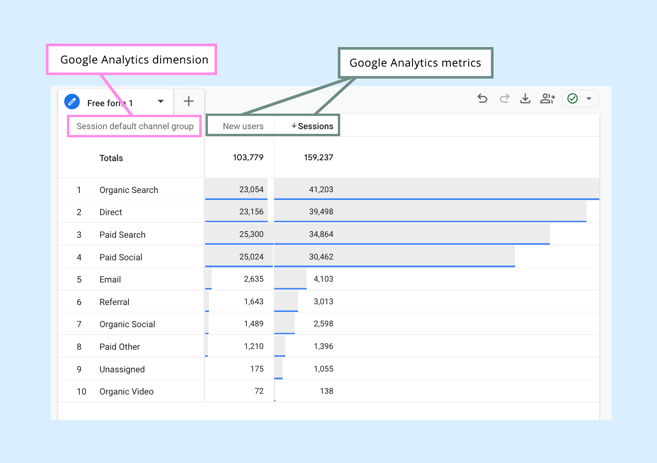Understanding the 'Secondary Dimension' in Google Analytics: Total Summary
Understanding the 'Secondary Dimension' in Google Analytics: Total Summary
Blog Article
Decoding the Relevance of Second Measurement in Google Analytics: Everything About Its Value and Influence
In the world of digital analytics, the utilization of additional dimensions within Google Analytics functions as an essential device for discerning much deeper layers of information insights. The significance of second dimensions depends on their ability to supply a nuanced view of user habits and communication with a site or system. By exploring information past surface-level metrics, organizations can open a wide range of details that shapes calculated decisions and refines marketing initiatives. This exploration into the realm of additional dimensions not only uses a detailed understanding of individual engagement yet likewise clarifies the detailed dynamics that drive online efficiency.
Recognizing Second Measurements in Google Analytics
The understanding of secondary measurements in Google Analytics is important for gaining much deeper insights right into customer habits and website efficiency. While key dimensions offer essential data points such as website traffic resources and page sights, secondary measurements permit a more nuanced evaluation by supplying added context to these key metrics. By including second measurements, customers can section and filter their data to discover patterns and patterns that may not be immediately obvious.

Introducing the Benefits of Second Dimensions
Structure upon the fundamental understanding of secondary dimensions in Google Analytics, discovering the benefits they supply exposes very useful insights for improving information analysis and decision-making. By including second dimensions, customers can delve much deeper into their data, getting a much more detailed view of individual habits, material performance, and various other essential metrics.
Moreover, second measurements give context to main information, providing extra layers of info that can assist in recognizing individual communications and choices. This improved understanding can guide calculated decision-making, causing more targeted advertising projects, web site optimizations, and general enhanced efficiency. Fundamentally, second dimensions function as an effective tool for unlocking deeper insights and optimizing the utility of Google Analytics for businesses and internet site owners.
Leveraging Secondary Dimensions for Improved Insights
By using the power of additional measurements in Google Analytics, services can uncover deeper understandings that drive informed critical and decision-making optimization efforts. Leveraging secondary measurements permits services to delve beyond surface-level information and obtain a more comprehensive understanding of customer habits, target market demographics, website traffic sources, and web site efficiency. As an example, by combining key measurements like web traffic sources with secondary dimensions such as geographical place or tool classification, organizations can determine which areas or devices are driving news the most important website traffic to their web site.
Additionally, second measurements make it possible for businesses to segment and examine information better, helping them identify fads, patterns, and opportunities that may have otherwise gone undetected. By making use of secondary measurements, businesses can tailor their advertising and marketing techniques, web content, and customer experience to far better meet the needs and choices of their target audience. In significance, leveraging secondary dimensions in Google Analytics encourages companies to make data-driven choices that lead to improved performance, boosted ROI, and sustainable development.

Effect of Second Measurements on Data Analysis
Enhancing information analysis via the usage of second dimensions in Google Analytics provides organizations with a deeper understanding of their on the internet performance metrics. By including secondary dimensions, such as time of day, geographic location, or gadget classification, companies can discover beneficial insights that might have been ignored with primary dimensions alone. This improved level of granularity enables even more accurate division of data, making it possible for companies to recognize patterns, patterns, and relationships that can drive strategic decision-making.

Maximizing Potential: Additional Dimensions Approaches
The strategic usage of secondary measurements in Google Analytics extends beyond improving data evaluation; it includes crafting targeted methods to open the complete possibility of beneficial insights for company growth. By employing additional dimensions effectively, businesses can dig deeper into their website traffic, individual website here habits, and advertising projects to extract actionable understandings. One essential strategy is to combine second measurements with main dimensions to obtain a detailed view of customer interactions. Combining the primary measurement of 'source/medium' with additional dimensions like 'touchdown web page' or 'device category' can expose which channels are driving website traffic to certain web pages or how individual behavior varies her comment is here throughout devices.
Additionally, using secondary dimensions to section information based upon customer demographics, habits, or technology can aid organizations tailor their advertising and marketing efforts to specific target market sectors. This targeted technique can bring about boosted conversion rates, enhanced user experiences, and eventually, enhanced ROI. By maximizing the capacity of second measurements in Google Analytics, services can make informed decisions, maximize their on the internet existence, and drive sustainable growth.
Final Thought
In final thought, second dimensions in Google Analytics play an important role in providing much deeper insights and enhancing information evaluation. Integrating second measurements right into information analysis approaches can lead to even more educated decision-making and boosted total performance.
While primary measurements give basic information factors such as traffic sources and page views, secondary dimensions allow for a much more nuanced evaluation by offering added context to these primary metrics. By combining key measurements like traffic resources with additional measurements such as geographical location or gadget classification, businesses can determine which tools or areas are driving the most beneficial website traffic to their site.
By including additional measurements, such as time of day, geographical area, or tool classification, businesses can reveal valuable understandings that might have been ignored with primary dimensions alone. One essential method is to integrate additional measurements with primary dimensions to get a comprehensive sight of user communications. Coupling the key measurement of 'source/medium' with second measurements like 'touchdown web page' or 'gadget classification' can disclose which channels are driving web traffic to particular pages or just how customer habits varies throughout gadgets.
Report this page